HR System Integration: The Ultimate Guide For Businesses 2025
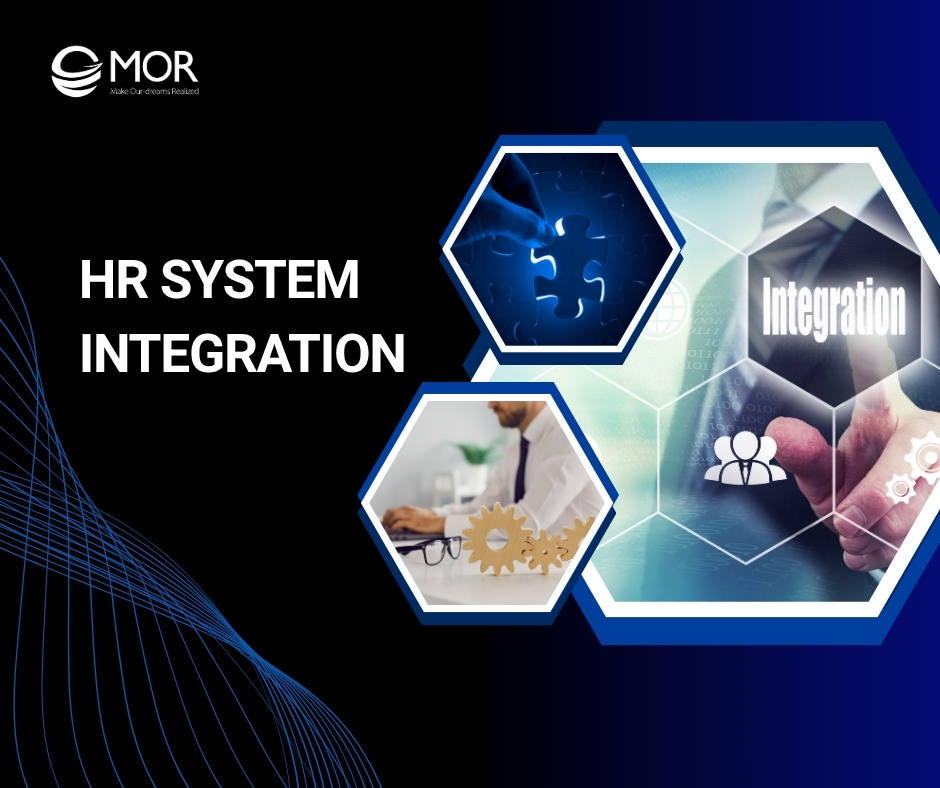
Managing people shouldn't mean juggling disconnected systems, duplicate data, or endless manual tasks. If your HR team is still wasting time syncing records across platforms, it’s time to look at HR system integration. This integration can help you cut costs, reduce errors, and work smarter, not harder. This MOR Software’s guide will walk you through what it really means, when to consider it, and how to do it right in 2025.
What Is HR System Integration?
At its core, HR system integration connects all your HR tools so they work together, not in silos. It helps unify workforce planning, payroll, onboarding, compliance, and other people-related functions into one seamless process.
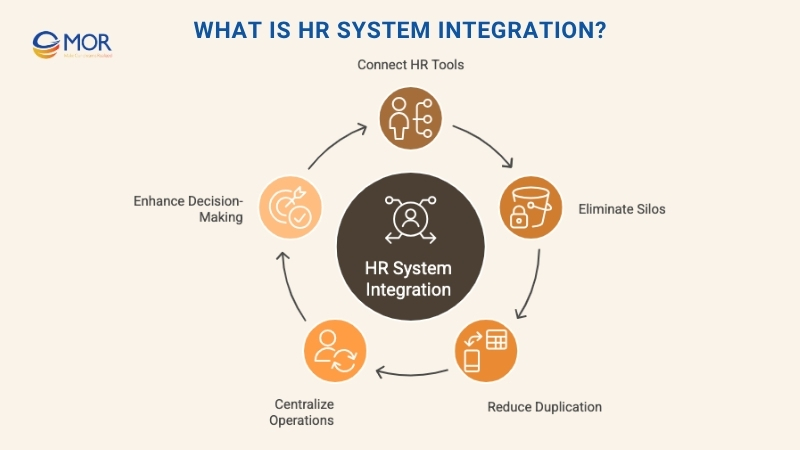
HR managers wear many hats. They handle daily tasks, keep up with legal requirements, and help shape long-term strategies. Most of their responsibilities fall into three buckets:
- Operations
- Compliance
- Strategic planning
There’s no shortage of HRM models today. But the problem? Each one might solve a different need. That means teams often juggle disconnected tools. A 2024 HR Executive survey found that organisations now run an average of 21 separate HR applications, up from eight in 2019, while HR.com reports only 13% rely on a single HR platform.
This is where an integrated HR system makes a difference. It turns scattered solutions into a connected, smart network by staying:
- Flexible to your needs
- Scalable with your growth
- Smooth to use, with no clunky workflows
Bringing everything together through HR integration lets your HR department run smarter. Your systems won’t just track time or process payroll, they’ll support smarter decisions and align with your company goals.
Whether you’re managing 50 or 5,000 employees, a well-connected HR platform ensures every part of the employee journey works in sync. That’s why more businesses now turn to HR data integration services to get the full picture and move faster.
Key Benefits Of HR System Integration
Bringing your systems together with HR system integration helps HR teams move faster, work smarter, and reduce errors. Below are some key benefits that make integration worth the effort.
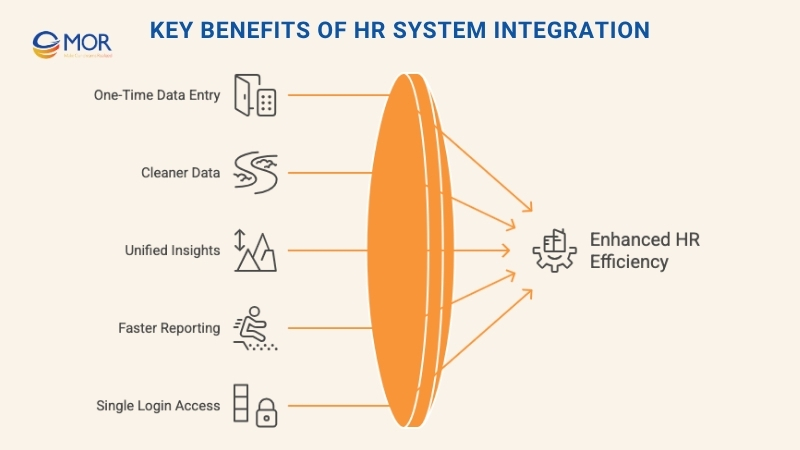
One-Time Data Entry
Tired of entering the same employee info over and over? With an integrated payroll and HR systems setup, you only need to input data once. Add a new hire in the main HR system, and your learning platform, time tracking, or HR analytics tools updates automatically.
ADP’s 2024 Global Payroll survey revealed that 22% of payroll teams spend more than 30 hours each week reconciling HR and payroll data, and Smartsheet research shows employees lose about a quarter of their workweek to manual, repetitive tasks. That alone saves hours every month.
For HR teams, this means less manual work and more time to focus on projects that actually support people, like employee development, wellness, or engagement.
Cleaner, More Reliable Data
Mistakes happen. And when you're entering the same info across multiple platforms, those mistakes multiply. With HR software integrations, data flows smoothly between tools, reducing the chances of errors like typos or mismatched records.
It also gives staff more self-service power. Instead of chasing down different systems for updates, they get the right info in one place. That cuts down paperwork and speeds up the entire employee journey.
An integrated HR and payroll systems approach doesn’t just simplify data handling. It helps everyone work with the same, accurate information, from HR to finance to compliance.
Unified, Trustworthy HR Insights
HR system integration gives your business a single, complete view of your workforce. When data is locked in separate systems, you miss patterns and trends that could guide smarter decisions. Siloed info slows you down and creates blind spots.
A connected system solves that. With everything, from hiring data to time logs, updated in one place, you get clearer insights into what’s working and what’s not. This central view makes it easier to adjust strategy, allocate resources, or fix issues before they grow.
That’s the value of an integrated HR payroll management system: one version of the truth, shared across your organization.
Faster, Smarter Reporting
With your HR data centralized, reports become quicker to build and more reliable. No more waiting on spreadsheets from different tools. You’ll spot problems and opportunities sooner because all the key numbers are right there.
Systems that integrate payroll, time tracking, performance, and planning bring it all together. A cloud-based performance management setup can track attendance, productivity, and compensation in one place. These data points are powerful, not just for compliance or recordkeeping, but for guiding real-time decisions.
This kind of reporting power is what makes ERP HR systems valuable to businesses trying to scale or streamline.
Simple Access With One Login
Managing multiple logins for different platforms slows everyone down. With HR system integration, single sign-on (SSO) lets employees and managers access everything they need through one secure portal. No more juggling passwords or wasting time switching between systems.
This kind of setup makes day-to-day work easier. Whether you’re reviewing benefits, updating personal details, or approving time off, it’s all in one place. And with integrated HR and payroll systems, tasks flow more smoothly across departments.
Besides convenience, SSO also tightens control. It reduces security risks by limiting how many access points need to be managed. That’s why many businesses prioritize tools with HR software integrations that support end-to-end workflows and safe access.
Common Types Of HR System Integration To Consider
Different departments use different tools, but when those tools don’t talk to each other, it slows everything down. With HR system integration, you can connect critical platforms across your organization for smoother operations and less manual work.
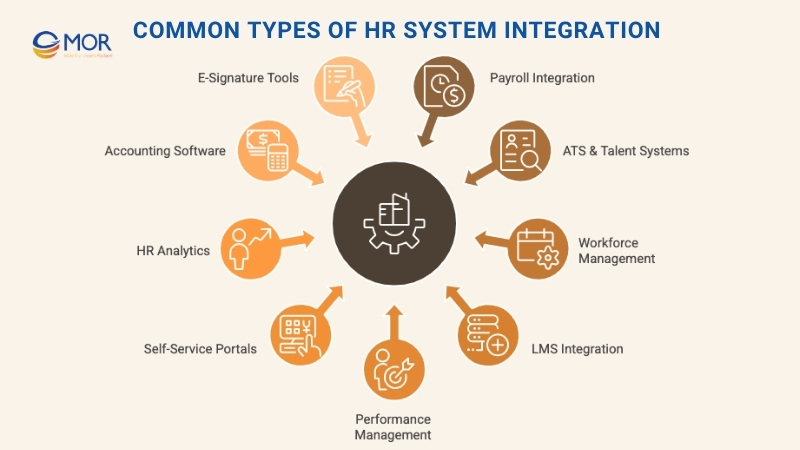
Payroll Integration
Payroll is non-negotiable. Yet many teams still manage it separately from their core HR platform, which means entering the same data twice. That’s a recipe for errors and wasted time.
U.S. Bureau of Labor Statistics data shows companies experience an average payroll error rate of 1.2% per pay period, costing a 100‑employee firm more than $56,000 a year, while PwC analysis reveals FTSE 100 companies lose between £10 million and £30 million annually to payroll mistakes.
An integrated HR payroll system ensures that employee records, hours worked, and compensation details all sync automatically. If someone’s pay rate or job title changes, the update flows into payroll in real time. This setup cuts down on mistakes, simplifies audits, and frees up your HR team to focus on more important work.
A well-connected system that integrates payroll also improves accuracy in compliance and tax reporting.
Talent Management System And Applicant Tracking System
Hiring is time-consuming, but it doesn’t have to be. Connecting your ATS with job boards, your company website, and social media makes it easy to post new roles and track candidates across platforms.
Select Software Reviews notes that 86% of recruiters say their ATS has reduced time‑to‑hire, a finding echoed by HiringThing’s 2024 data, which reports the same percentage of users seeing faster hiring cycles.
With an integrated HR system, you can store candidate info, schedule interviews, and manage onboarding all in one place. That helps you move faster from posting a job to filling the role, without losing qualified applicants along the way.
Workforce Management Tools
Tracking schedules, shifts, performance goals, and productivity requires coordination. When your workforce management tool is connected to your HR system, data flows in both directions.
This type of HR integration gives managers better visibility into labor usage and employee availability. It also streamlines reporting and allows smarter planning across departments. Centralized data means better decisions, fewer surprises, and more consistent performance.
Learning Management System (LMS)
When your LMS syncs with your HR platform, training becomes part of the bigger picture. Instead of tracking courses and employee data separately, you can connect them. That means fewer manual updates and fewer chances for errors.
An integrated HR system links employee IDs directly to training records. It’s easier to see who completed what, where they’re behind, and what skills they’re building. Plus, it improves reporting. You get a clearer view of how learning connects to performance, growth, and career hr development, all in one dashboard.
Performance Management
With performance management tools linked to your core HR platform, you get a smarter way to handle evaluations and feedback. Goals, appraisals, and progress are automatically shared across systems, which keeps everything consistent.
This also removes guesswork during review season. Everyone’s working from the same data set. For leadership, it means fairer reviews. For employees, it builds trust in the process. And for HR? Less copy-pasting between platforms and more time focusing on strategy.
That’s the strength of HR software integrations, they make feedback loops tighter and more transparent.
Employee Self-Service Portals
Empowering your team to manage their own info can save your HR staff hours. With self-service tools tied into your main system, employees can view or edit their records without needing back-and-forth emails.
That includes updating contact details, submitting leave requests, reviewing benefits, or checking payroll. A setup like this, using integrated payroll and HR systems, reduces admin work and gives staff more control over their time.
HR Analytics
Want deeper insights into how your strategies are working? HR system integration lets you pull data from multiple tools, your HRIS, LMS, ATS, and performance trackers, and analyze it together.
With HR analytics, you can spot patterns in retention, hiring quality, training results, or engagement. Instead of looking at reports in isolation, you get connected data that helps you act faster and smarter.
This is where HR data integration services pay off. They help turn scattered records into clear, business-ready insights.
Accounting Software
Another type of HR system integration is accounting software. HR and finance need to stay aligned. When your accounting platform links directly with payroll and HR tools, it simplifies tracking wages, taxes, and benefits.
You don’t have to reconcile numbers manually, and compliance becomes much easier. Integrated reporting ensures accuracy in audits, budgeting, and filings. It’s a smart way to reduce risk while saving time.
This is one of the most practical use cases for integrated payroll and HR systems in mid-sized and growing businesses.
E-Signature Software
Signing documents doesn’t have to be a bottleneck. When you link digital signature tools to your HR system, the process moves faster, from offer letters to contracts and exit paperwork.
It also helps with compliance. All signed docs are stored securely in one place, easy to retrieve when needed. Plus, you’ll avoid version mismatches or lost files.
This type of integration makes onboarding smoother, especially when paired with a full-stack integrated HR system.
When Should Businesses Consider HR System Integration?
HR system integration isn’t something you implement on a whim. It takes time, planning, and budget. But for many organizations, the payoff is worth it, especially when your current setup is slowing you down or missing key features.
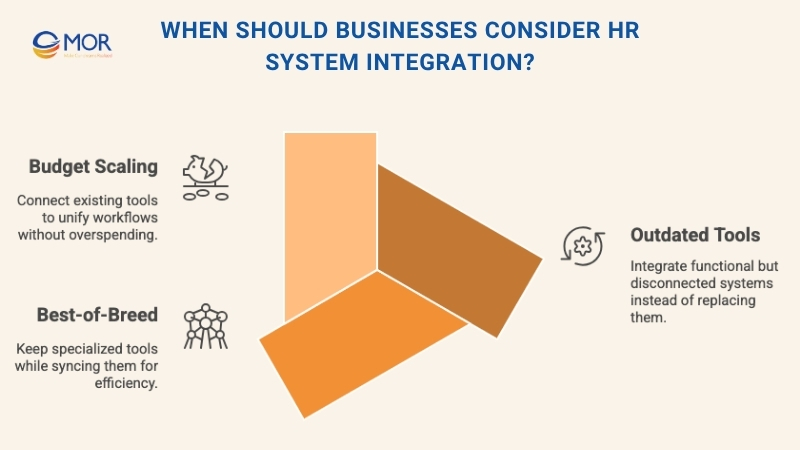
Below are some common situations where integration makes the most sense.
Your Current HR Tools Are Behind
If your existing HR system feels clunky or incomplete, it might be time to upgrade. Basic platforms often cover essentials like payroll or time-off tracking but fall short in areas like recruitment, performance reviews, or training.
That’s when companies start adding more tools, but managing disconnected apps gets messy fast. Instead of replacing everything, you can use HR system integration to link your existing tools. You’ll keep what works while building a more connected system.
You Prefer Specialized Solutions Over All-In-One
Some companies go the all-in-one route. Others want the best tools for each job. Maybe your recruitment software is top-tier, your LMS fits your learning strategy, and your performance platform works great on its own.
You don’t have to give those up. Integration lets you keep your favorite tools and still sync data across systems. It’s a smarter way to build a tech stack, using only what fits your business needs.
In this case, bringing together multiple best-in-class platforms with HRM management softwares gives you the flexibility of specialization with the efficiency of a single system.
Your Budget Supports A Smarter Mix
Maybe your business needs a range of features, payroll, recruitment, training, analytics, but buying a full-service suite just isn’t in the cards right now. Or maybe you've already invested in separate tools that do their jobs well, and replacing them all would be expensive and disruptive.
That’s where HR system integration becomes a smart middle ground. Instead of rebuilding from scratch, you connect what you already use. This approach lets you create a unified workflow without overspending.
By integrating existing systems, you get the benefits of a connected solution while staying within budget. It’s a practical move for businesses looking to scale wisely, especially those already using integrated HR and payroll systems or standalone HR tools that work well but lack connectivity.
Questions To Ask Before Moving Forward With HR System Integration
Before committing to any major tech upgrade, it’s smart to step back and ask the right questions. HR system integration isn’t just about syncing tools, it’s about making sure those tools work together to support your goals.
Here are 4 key questions to guide your planning.
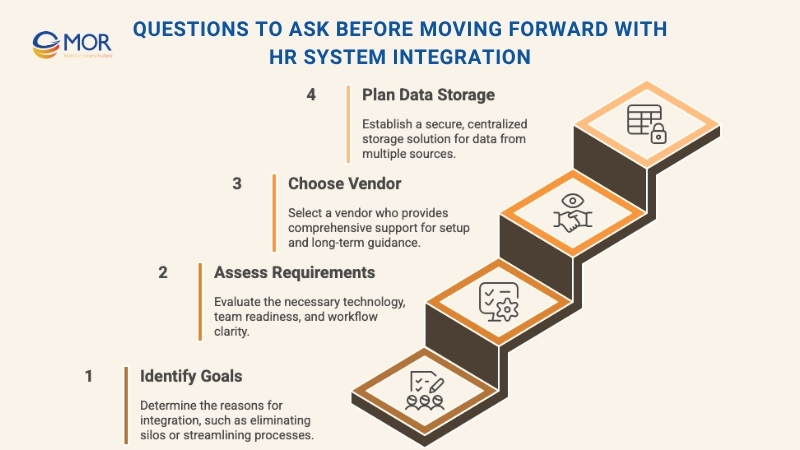
What’s Driving This Integration?
Start with the “why.” What are you hoping to fix or improve?
- Are you trying to break down data silos caused by multiple HR platforms?
- Do you want to improve how your teams access and use employee data?
- Is your goal to increase productivity or deliver a smoother employee experience?
Having a clear purpose will keep your integration focused. If your aim is to improve efficiency, reduce duplication, or unify reporting, you’ll make smarter decisions when picking systems and setting expectations.
This is especially important if you’re adding something like an integrated HR system to bring order to your current setup.
What’s Needed For It To Work Well?
Every integration comes with requirements. Think about what you’ll need, technical support, stakeholder buy-in, realistic timelines, and a full map of your existing workflows.
Make a list of what could help or hinder the rollout. For example:
- Do your systems already have APIs or connectors?
- Will HR and IT need to work together on user roles, data mapping, or testing?
- Are your current processes clear enough to automate?
Understanding how your tools and teams operate will make the transition smoother. If you’re already using platforms that support HR software integrations, this can give you a major head start.
Will The Vendor Help Or Leave You Hanging?
Before jumping into HR system integration, find out if your vendor offers support. Will they guide you through setup? Help with system mapping? Offer tech support during the rollout?
If so, you’ll save time and reduce the load on your internal IT team. Vendors who know their product inside and out can help avoid common pitfalls and shorten the learning curve.
Their input matters, especially when connecting third-party tools or navigating complicated setups. Experienced vendors often provide templates, checklists, or automation tools that simplify the process. This is a major plus when dealing with complex HR software integrations.
Where Will All That HR Data Live?
Once you’ve connected your tools, you need a plan for storing and accessing all that data. Will it sit in a cloud-based system? A secure internal server? Or a mix of both?
The answer depends on your goals. If you’re syncing information across time tracking, payroll, and learning tools, you may need a centralized solution like a data warehouse or data lake.
These setups help you organize information from different sources into one place, which makes reporting faster and more accurate. It’s a big part of making an integrated HR system work long term, especially if you want to scale without slowing down.
Potential Challenges In HR System Integration
HR system integration can bring big improvements, but it also comes with hurdles. Before starting, it's important to understand what could slow you down or create risk. Planning for these issues early helps make integration smoother and more successful.
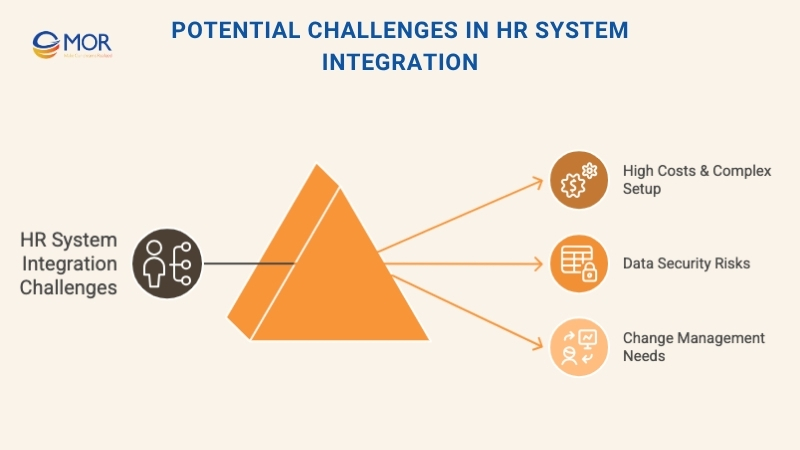
Costs And Implementation Complexity
Integration isn’t always plug-and-play. Depending on how many tools you're connecting and how customized they are, it can get expensive fast. Licensing fees, development hours, and potential downtime all add up.
If you're not using pre-built connectors or working with experienced vendors, you'll likely need extra resources. Custom APIs, testing environments, and workflow mapping can stretch your timeline and budget. That’s why many businesses look for HR data integration services to simplify the technical side and stay on track.
Data Privacy And Security Concerns
More systems talking to each other means more data moving around. Without proper controls, this can open the door to data leaks, breaches, or unauthorized access.
IBM’s 2024 Cost of a Data Breach study pegs the average global breach at $4.45 million, and Secureframe research shows the figure rises to $4.88 million when cloud environments are involved. This shows the stakes for integrated HR platforms.
It’s critical to protect sensitive employee data, salaries, health records, performance reviews, with role-based access, encryption, and audit trails. Make sure every tool involved in your HR system integration meets your security standards, especially if you're storing data in the cloud or using third-party services.
Need For Change Management And User Training
Even the best system won't deliver results if people don’t know how to use it. Integration changes how teams work, sometimes in big ways. That can lead to confusion or pushback if you're not prepared.
Clear communication, step-by-step rollout plans, and hands-on training are essential. It’s not just about the tools, it’s about helping HR, IT, finance, and managers work together in new ways.
When rolling out integrated HR and payroll systems, for example, make sure employees understand what’s changing, why it matters, and how to get help when they need it. That human element can make or break your success.
Choose MOR Software For HR System Integration
MOR Software builds HR systems that don’t just work. They connect, scale, and support real teams in real time. We understand that HR leaders today need more than just a tool. They need a system that ties everything together: payslip, performance, onboarding, attendance, and beyond.
We’ve helped businesses unify siloed systems, automate repetitive admin work, and turn fragmented HR data into one clear, usable source of truth. Whether you're upgrading legacy tools or building from scratch, we provide technical depth service, strategic input, and long-term support.
Here’s what makes us a reliable partner for your HR system integration:
- Tailor-made HR platforms built to match your exact processes
- Smooth integration with tools like Salesforce, PitTouch, and custom software development outsourcing
- Scalable cloud infrastructure with built-in SSO and role-based security
- Support across all phases: from planning to post-launch maintenance
- Proven experience across finance, manufacturing, healthcare, and more
- Strong collaboration with your IT and vendors to reduce handoffs
- Clear documentation, onboarding, and change support for your team
Want a system that works how your HR team actually operates? We’ll help you build it.
Conclusion
HR system integration isn’t just a tech upgrade, it’s a smarter way to run HR. By connecting tools across payroll, recruitment, performance, and analytics, your team spends less time on admin and more time driving results. If you're ready to simplify your HR operations and build a connected system that fits your business, contact MOR Software. Our team is here to help you integrate with confidence.
MOR SOFTWARE
Frequently Asked Questions (FAQs)
What is HR system integration?
HR system integration connects different HR tools, like payroll, time tracking, and recruitment, so they share data and work together. It helps avoid duplicate data entry and makes information easier to access and manage.
Do I need a full-suite HR platform to integrate my systems?
Not necessarily. Many businesses use separate tools for specific needs. Integration lets these tools communicate, even if they come from different providers. The goal is to keep everything in sync without forcing a full platform switch.
How long does it take to integrate HR systems?
Timelines vary depending on how many tools you're connecting and how complex your workflows are. A simple integration can take a few weeks. Larger projects with custom APIs or data migrations may take several months.
What are the biggest risks with HR system integration?
Common issues include data mismatches, poor planning, security gaps, and lack of user training. Having clear goals and working with experienced teams can reduce these risks.
Will integration affect day-to-day HR operations?
It might during setup, but the goal is to make daily tasks easier in the long run. With smart planning and communication, teams can keep working while systems are being connected in the background.
Rate this article
0
over 5.0 based on 0 reviews
Your rating on this news:
Name
*Email
*Write your comment
*Send your comment
1